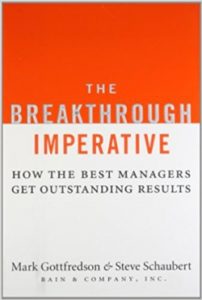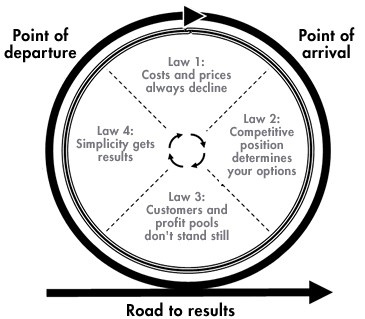The Breakthrough Imperative (Book Review)
 Book
Book
Gottfredson, Mark and Steve Schaubert. (2008). “The Breakthrough Imperative – Developing an impactful strategy.”
Reviewer
Dr. Michael Boehlje, Professor Emeritus, Department of Agricultural Economics
Summary
Developing strategy is tough stuff. Because it is so difficult to do, many strategy documents turn out to be a “check the box – we got one” set of slogans that don’t really inform decisions and are difficult to implement. Consequently, the pithy strategy statement is not translated into real work, which is essential to improve the performance of the business. So how do we solve this dilemma?
Gottfredson and Schaubert, principals in the consulting company Bain & Company, provide a useful framework to develop a more impactful strategy in their 2008 book, The Breakthrough Imperative: How the Best Managers Get Outstanding Results. They initiate their discussion by describing “four laws” that characterize any industry, as reflected in Figure 1. These laws are then used to set up a set of 12 questions (Figure 2) to inform data collection and analysis that are critical to craft an impactful strategy and achieve and sustain long-term breakthrough performance.
 What this means for food and agribusinesses
What this means for food and agribusinesses
So what does this mean to agribusiness managers? The food production and distribution system is facing intense pressures and profound changes: new technologies, new competitors, new business models, and increased consumer scrutiny. The four laws (themes) and the questions that accompany them provide a comprehensive framework for developing a winning strategy in this disruptive and chaotic business climate. For example, answering the question of which products or services are making money and why or why not (Question 3 in Figure 2) will help inform the sales/marketing focus, as well as the growth strategy for ag retailers. This requires knowing the operating margins on sales, not just for the crop protection division for example, but at the level of the specific product and service offered.
Knowing your key sources of competitive advantage (Question 6 in Figure 2) is critical to determining the focus of your allocation of personnel and financial resources. Are you better than your competitors in product innovation and bringing new products to market? Are you a more reliable supplier? Is your sales force better informed to answer your customer’s questions? Do you have the lowest price, or a competitive price but the best value proposition? Answers to these market positioning questions are essential to a successful strategy.
Who are the fastest growing and most profitable customer segments you serve (Question 7 of Figure 2) and what proportion are you retaining (Question 8 of Figure 2)? Knowing how profit pools change over time and assessing your need to pivot your marketing/sales focus from customers that no longer generate acceptable profit margins to those who have more potential today and tomorrow is an important component of strategy.
Assessing the complexity of your product/service offering and how it impacts the ability of your sales force to explain the features and benefits to the customer is also important. Customers generally prefer less complexity in decision making—they want effectiveness and ease in using your product or service as proven by Monsanto’s success with Roundup technology.
Getting answers to these 12 critical questions can provide the building blocks for a well-crafted strategy. Gottfredson and Schaubert provide a template and a set of very specific analytical tools to obtain those answers. The Breakthrough Imperative is not just an interesting read on crafting an impactful strategy, it is almost a workbook to get the task done.

RELATED POSTS:
A great moment for value-based sales in agribusiness
Value-based sales can empower companies to craft compelling value propositions, understand the customer’s business model and effectively communicate to stakeholders.
How can big data empower the development of new products?
Data is one of the most powerful resources for a company. It enables accurate decision-making and minimizes risk, ensuring greater revenue and sustainable growth.
Unlocking Growth: Exploring innovation dynamics in the agrifood sector
The future for the agrifood sector appears promising, driven by technological advances, strategic M&A activity and a growing commitment to innovation.

